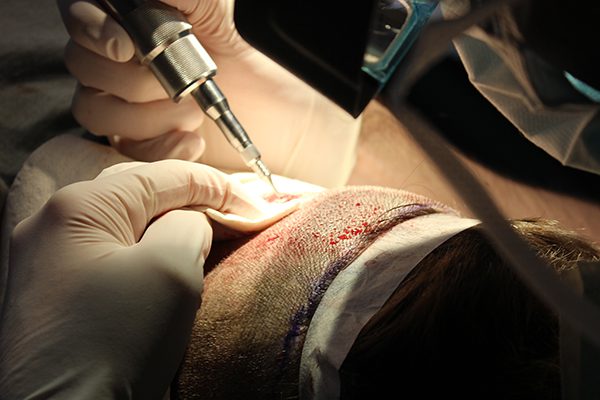What is FUE?

FUE, or Follicular Unit Excision (previously Follicular Unit Extraction), is the other widely available and popular harvesting method – the other being the “FUT” or “strip” harvesting technique. Unlike the strip technique, where a small strip of hair-bearing skin is removed as one piece from the donor region and divided under microscopes into follicular unit grafts for implantation, the FUE technique uses tiny tools to individually cut around follicular units and remove them “one-by-one” from the donor region. Using circular “punch” tools ranging from 0.7mm to 1.3mm in diameter, a doctor performing an FUE procedure carefully “scores” or cuts around an individual follicular unit in the donor region, and then uses forceps (tweezers) to pluck or pull the unit out of the skin. The small hole created by the removal is left open to heal into a “dot” scar. This means no sutures (stitches) or staples are required for the FUE technique. The extracted graft is then examined under microscopes, refined, and implanted into the bald scalp the same way it is during an FUT procedure.
Unlike the strip technique, the FUE technique does not leave a linear incision scar in the donor region. Instead, it leaves thousands of small “dot” scars created by the graft removal. In the right patient and when done appropriately, this scarring tends to be less noticeable and allows patients to wear shorter hair styles in the back. It is important to note that there is no such thing as a “scar less” hair transplant procedure, and FUE does creating scarring which is visible if the donor area is trimmed close enough. Estimates vary, but most patients can go down to around a “#2” (1/4 inch of hair) before the FUE scarring is visible – whereas FUT patients can typically go down to a “#3” (3/8th of an inch) before the linear scar is visible. A larger portion of the donor area must be utilized in FUE procedures (to avoid “over harvesting” and creating thin patches), so the entire back of the head must be shaved during an FUE surgery (which differs from FUT where it is typically left long). This can make concealing the procedure in the immediate post-operative period more difficult.
Since its mainstream introduction in the early 2000s, FUE has faced, and still does face, its fair share of controversy. Much of the controversy surrounding the technique involves debate over the success rate and results compared to FUT, the appropriate size of FUE sessions, the way in which the procedure is marketed, and the proliferation of non-doctor FUE clinics.
Studies comparing the growth rate of FUE to FUT are somewhat sparse. The data we do have varies, showing growth as different as 24.6% difference between FUE and FUT (Beehner, 2016) to nearly no difference (Josephitis and Shapiro, 2018) when performed in a small session and in a meticulous manner. What this data does show, however, is greater variability when compared to FUT harvesting. Anecdotally speaking, most physicians who perform both FUT and FUE do find greater consistency with FUT. Most who perform both procedures also agree that FUE is best suited for smaller sized surgeries and there can be serious consequences to the donor region when attempting FUE at the “mega session” level. This is because the removal of grafts individually creates a thinning effect in the donor. If too many grafts are removed at once or from a specific area, a generalized thinning effect or the appearance of “blown out” patches may occur in the donor. This is why most doctors recommend smaller FUE sessions or beginning with FUT and then moving to FUE later – though, again, opinions vary. The most significant point of contention in the FUE field, however, is the recent wave of aggressive online marketing and the subsequent proliferation of non-doctor FUE clinics. Several large medical device manufacturing companies have developed “turn key” FUE systems and now market these devices and protocols to non-hair transplant doctors looking to add revenue in their practices. These companies claim the device allows them to seamlessly perform a very delicate and meticulous procedure without any experience necessary, and even offers to send technicians to perform the procedure if the doctor is not comfortable with the surgery or simply does not want to dedicate the time to perform the surgery – a highly illegal practice in the United States. This shift towards technician-run procedures and profit-driven FUE has devolved even further in certain countries and given rise to clinics where FUE is performed 100% by technicians. In these clinics, the doctor will see the patient in the morning, make some surgical markings, and then turn the case over to technicians. These technicians are told how many grafts to remove and where they need to go, and all medical and surgical decisions are made by non-physicians with no legal or moral responsibility to the patient. As suspected, the proliferation of this model has led to serious complications, disastrous results, and victimized patients. Those considering FUE procedures should be wary of this model. Patients should seek a team experienced in both FUT and FUE with a dedicated clinic and protocol, and a track record for performing quality FUE.
References
Beehner, M.L. (2016). FUE vs. FUT-MD: Study of 1,780 Follicles in Four Patients. Hair Transplant Forum
International. 2016; 26(4): 160-161
Josephitis, D., Shapiro, R. (2018). FUT vs. FUE Graft Survival: A Side-by-Side Comparison of Three
Patients Undergoing a Routine 2,000+ Graft Hair Transplantation. Hair Transplant Forum
International. 2018; 28(5): 179-182





